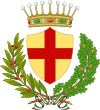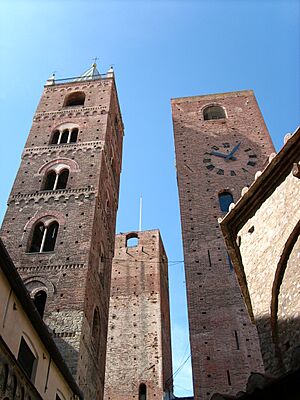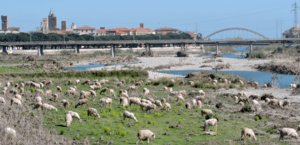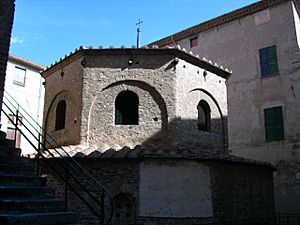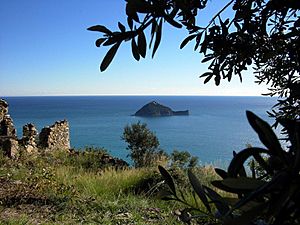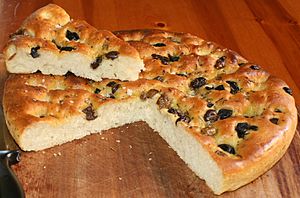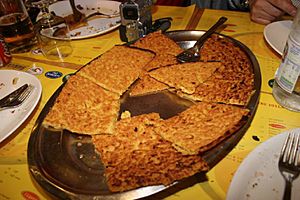Albenga facts for kids
Quick facts for kids
Albenga
|
|||
|---|---|---|---|
| Comune di Albenga | |||
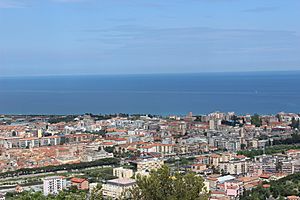 |
|||
|
|||
| Country | Italy | ||
| Region | Liguria | ||
| Province | Savona (SV) | ||
| Frazioni | Bastia, Campochiesa, Leca, Lusignano, Salea, San Fedele | ||
| Area | |||
| • Total | 36.51 km2 (14.10 sq mi) | ||
| Elevation | 5 m (16 ft) | ||
| Population
(31 December 2010)
|
|||
| • Total | 24,378 | ||
| • Density | 667.71/km2 (1,729.35/sq mi) | ||
| Demonym(s) | Ingauni or Albenganesi | ||
| Time zone | UTC+1 (CET) | ||
| • Summer (DST) | UTC+2 (CEST) | ||
| Postal code |
17031
|
||
| Dialing code | 0182 | ||
| Patron saint | Saint Michael the Archangel | ||
| Saint day | 29 September | ||
Albenga is a city in northern Italy, located on the Italian Riviera in the Liguria region. It's found on the Gulf of Genoa.
Albenga is often called the city of a hundred spires because of its many tall towers. Its economy mainly relies on tourism, local shops, and farming. The city also includes six smaller villages, known as hamlets: Lusignano, San Fedele, Campochiesa, Leca, Bastia, and Salea.
Contents
What's in a Name?
The name Albenga comes from the Latin word Albíngaunum. This name developed over many centuries. It started as Album Ingaunum, meaning "capital city of the Ingauni". The Ingauni were an ancient tribe from this area.
The word Album comes from an old word meaning "rock" or "hill". It's often mistakenly linked to the Latin word for "white". After the Romans conquered the area, the name became Albingaunum. Over time, it changed to Albinauno and then Albingano. The name "Albenga" finally appeared in the 14th century.
Albenga's Long History
Early Beginnings
Albenga was founded around the 4th century BC. It was built on the slopes of a coastal hill. The city was once the main town for the Ingauni, a local tribe. The Ingauners were skilled sailors and traders. Their territory stretched between Finale and Sanremo.
Roman Times
During the Second Punic War, Albenga sided with the Carthaginians. However, the city was defeated by the Romans in 181 BC. The next year, Albenga and the Romans signed an alliance agreement called a foedus. This led to the whole region becoming Roman.
In 89 BC, Albenga gained Latin rights. Then, in 45 BC, under Julius Caesar, its people became Roman citizens. This started a time of growth and wealth for the city. The building of the Via Julia Augusta road in 13 BC further helped Albenga. This road connected the city to southern France and Spain. An old inscription tells us that the city's walls, market, and harbor were fixed in 354 AD.
Later Ancient Times
Even though there aren't many old records, discoveries show Albenga was important in Late Antiquity. In 451 AD, a bishop from Albenga attended a meeting in Milan. This suggests Albenga was a key religious center in western Liguria.
In the 5th century, the city faced attacks from the Visigoths. They partly destroyed and robbed Albenga. The old Roman town was in bad shape. But it was rebuilt with help from Emperor Constantius III. His support made the city stronger and helped it survive for many centuries.
The Middle Ages
Albenga became a self-governing city in 1098. In the same year, Albenga joined the First Crusade. It sent its own flag, soldiers, and money. In return, the King of Jerusalem gave Albenga free trade rights. From then on, a flag with a Golden Red Cross flew on its ships and towers.
Later, when Emperor Frederick Barbarossa invaded northern Italy, Albenga supported him. It joined the Ghibelline group, a choice it kept for centuries. In 1159, Albenga received official control over all its lands from the emperor.
Modern History
In 1798, Albenga became the capital of the Centa area. This was part of the short-lived Ligurian Republic. In 1815, the city and all of Liguria became part of the Kingdom of Sardinia. This kingdom was ruled by the House of Savoy, the Italian Royal family. Albenga became the main city of a new province. This province included towns from Andora to Finale Ligure and the countryside.
After Italy became one country in 1863, Albenga's province became a smaller district. It was completely removed in 1927. During this time, Albenga became more of a farming village. Other coastal towns grew faster in terms of money and people. Albenga was not a popular vacation spot like other towns on the Italian Riviera.
Albenga's Location
Albenga is on the western coast of the Italian Riviera. It sits on a flat plain at the mouth of the Centa river. Over the years, the Centa river has shaped Albenga's plain many times. This forced the people of Albenga to build walls and bridges from the city's beginning. Until the 17th century, Albenga's economy depended on sea trade. The city was built at the river's mouth and surrounded by walls and bridges. Over time, the Centa river changed its natural path.
When Albenga was taken over by the Republic of Genoa, the Republic decided to fill in the port. This was done to punish the city and stop any future rebellions. Today, the river flows past the city center and out to sea. The memory of the old bridges has almost disappeared.
Albenga is the main city of the "Albenganese" district. This area stretches from Finale to Andora and includes all the countryside. The Gallinara island is also part of this district. It is believed that the Christian saint Martin of Tours once lived on the island. A monastery now stands there in his honor. Since 1064, the island has belonged to the abbey of Abbadia Alpina.
Weather in Albenga
The climate along the coast is mild. Winters are gentle, and summers are warm. Sea breezes help keep the extreme heat away, so summers are rarely very hot. However, the countryside on the Albenga plain has colder winters and hotter summers than the coastal area.
| Climate data for Albenga (1961–1990, extremes 1953–present) | |||||||||||||
|---|---|---|---|---|---|---|---|---|---|---|---|---|---|
| Month | Jan | Feb | Mar | Apr | May | Jun | Jul | Aug | Sep | Oct | Nov | Dec | Year |
| Record high °C (°F) | 22.0 (71.6) |
24.6 (76.3) |
24.0 (75.2) |
28.0 (82.4) |
32.5 (90.5) |
35.0 (95.0) |
37.1 (98.8) |
37.0 (98.6) |
33.8 (92.8) |
29.3 (84.7) |
25.0 (77.0) |
22.0 (71.6) |
37.1 (98.8) |
| Mean daily maximum °C (°F) | 11.7 (53.1) |
12.4 (54.3) |
14.6 (58.3) |
17.4 (63.3) |
21.2 (70.2) |
25.0 (77.0) |
28.7 (83.7) |
28.5 (83.3) |
25.3 (77.5) |
21.1 (70.0) |
15.7 (60.3) |
12.7 (54.9) |
19.5 (67.1) |
| Mean daily minimum °C (°F) | 0.5 (32.9) |
1.3 (34.3) |
3.2 (37.8) |
6.2 (43.2) |
9.8 (49.6) |
13.3 (55.9) |
15.9 (60.6) |
15.7 (60.3) |
13.1 (55.6) |
9.1 (48.4) |
4.4 (39.9) |
1.4 (34.5) |
7.8 (46.0) |
| Record low °C (°F) | −12.4 (9.7) |
−11.0 (12.2) |
−8.0 (17.6) |
−3.0 (26.6) |
−1.0 (30.2) |
4.0 (39.2) |
6.6 (43.9) |
6.2 (43.2) |
3.7 (38.7) |
−1.8 (28.8) |
−6.6 (20.1) |
−8.6 (16.5) |
−12.4 (9.7) |
| Average precipitation mm (inches) | 101.4 (3.99) |
89.7 (3.53) |
90.4 (3.56) |
81.6 (3.21) |
76.1 (3.00) |
38.2 (1.50) |
21.3 (0.84) |
43.3 (1.70) |
55.0 (2.17) |
105.5 (4.15) |
96.8 (3.81) |
78.9 (3.11) |
878.2 (34.57) |
| Average precipitation days (≥ 1.0 mm) | 6.2 | 5.2 | 6.1 | 6.6 | 6.5 | 4.0 | 2.8 | 3.8 | 4.4 | 6.4 | 6.3 | 5.0 | 63.3 |
| Average relative humidity (%) | 73 | 73 | 72 | 79 | 79 | 79 | 77 | 77 | 78 | 78 | 75 | 76 | 76 |
| Source: Servizio Meteorologico | |||||||||||||
Main Sights to See
Albenga was built on an old Roman plan. The main roads of the Roman camp, called cardo and decumanus, are now "Via Medaglie d'oro" and "Via Enrico d'Aste". The heart of the town is San Michele Square. Around it, important buildings for political and religious leaders were built.
Cathedral of St Michael Archangel
This cathedral was built on the remains of an early Christian church. That church was ordered by Constantius III between the 4th and 5th centuries. The front of the cathedral shows changes from Romanesque to Gothic styles. Two side entrances on the main front and a third on the left side are from this time. The left side entrance has a restored Lombard carving. The main entrance was added in 1669.
The church's current look is due to many additions over time. Restoration work between 1964 and 1967 brought back its original medieval design. The bell tower next to the church was added in the 13th century. It was built between 1391 and 1395 over an older bell tower. This tower is one of the last local examples of using bare bricks before plaster became common.
Albenga Baptistery
The baptistery is next to the cathedral, which was common for early Christian buildings. You can visit it from the Loggia of the old City Hall Palace. Its inside is shaped like an octagon and dates back to the 5th century. Its current look comes from a restoration in the late 1800s. During that work, the original domed roof was destroyed. The mosaic decorations on the ceiling of the altar area are from the 5th and 6th centuries.
Old City Hall Palace
This palace dates back to the early 14th century. It has been changed many times to get its current look. It used to hold the Council Hall and the jail. A large bell still calls citizens when the council meets in the new town hall. The lower floor is from the 14th century, and the upper one was rebuilt between 1387 and 1391. The side facing the baptistery has castle-like tops called merlons. Since 1933, it has been home to the Ingauni Museum. This museum has Roman and medieval items like sculptures, writings, and old paintings.
Old Bishop's Palace
Located near the baptistery, this palace is from the 11th century. It has an entrance from the 13th century. It is where the local bishop lives and also holds the Holy Art Museum. The part leading to the baptistery shows different building styles from the 13th and 14th centuries. Black and white stripes were added in 1463. A painting of a family crest was done by Giovanni Canavesio in 1477.
The Diocesan Museum of Albenga is in rooms decorated with old paintings. It displays artworks and items found from digging around the cathedral. Among the paintings, you can see a St. John thought to be by Caravaggio. There is also The Martyrdom of Saint Catherine by Guido Reni.
Ancient Roman Remains
The Via Julia Augusta road was rebuilt by Emperor Augustus in 13 BC. It was the most important road on the Italian Riviera for a long time. It was used until a new road was built closer to the sea by Napoleon. The path of the Via Julia Augusta has many Roman buildings used for funerals. This makes it a beautiful walk with historical and natural views.
Albenga also has the remains of a Roman amphitheatre from the 3rd century BC. This is the only example of a Roman theater found in the western part of the Italian Riviera. Albenga is close to both the Amphitheatre and the Via Julia Augusta. A famous funeral monument called the Pilone stands on the eastern side of the Mount. This is a well-known monument from the Ingauner people.
Also in the mount area is the old Christian church of S. Calocero (4th–5th century). It was built over the tomb of a martyr.
Other interesting old sites include:
- South of the old town, an area was found during riverbank work between 2000 and 2002. Here, by the river, ruins of an old Roman bath system and an early Christian site with the medieval San Clemente Church were discovered.
- Pontelungo ("Long Bridge") is a medieval water system from around the 13th century. The Sanctuary of Nostra Signora di Pontelungo (early 18th century) is nearby.
- Palazzo Peloso Cepolla (16th century) has a corner tower from the 13th century. Its entrance hall has a painting of the Roman ruler Proculus. The main floor has many Roman marble busts. It is home to the Roman Naval Museum, started in 1950. This museum displays over a thousand Roman clay jars (amphorae). These were found from a ship that sank in Albenga's waters in the 1st century BC. It was the first Roman cargo ship found and explored in the Ligurian Sea. There is also a section about prehistoric items from the Val Pennavaira caves.
- Torre Oddo is a tower with typical Ghibelline-style tops.
- The piazzetta dei Leoni ("Lions' Square") is between the cathedral and the Costa family's medieval buildings. The Costa family brought three Renaissance-style stone lions to the square in 1608, giving it its name.
- The Museum of the Oil Civilization is in an old mill owned by the Sommariva family. It shows how olives, olive oil, and wine were made in the past.
Fun for Tourists
Albenga is an important historical town and a popular tourist spot on the Italian Riviera. The coast of Albenga is about 4 kilometers (2.48 miles) long. It has fine sand mixed with small stones. There are public beaches and private beaches with full services. The sea promenade is about 3 kilometers (1.86 miles) long.
The private island of Gallinara is less than one nautical mile from Albenga.
Learning in Albenga
Albenga has several secondary schools:
- Professional Institute of Agriculture and the Environment "Domenico Aicardi".
- State Industrial Technical Institute "Galileo Galilei".
- Scientific High School "Giordano Bruno" with a classical section "Giovanni Pascoli".
- "Redemptoris Mater" Diocesan School Center, a high school with classic and socio-psycho-pedagogical sections.
- The Diocesan Seminary is a historic school that has educated citizens for centuries. It is now in a modern building and trains future priests.
The Higher Institute of Religious Studies (ISSR) is a university that focuses on studying religion.
Delicious Local Food
Some local foods you might enjoy are:
- Purple Asparagus
- Trumpet zucchini
- Artichoke
- Beefsteak tomato
- Biscuits with fennel seeds, called Baxin d'Arbenga ("Kiss of Albenga")
- Extra virgin Taggiasca olive oil
- [Genoese Pesto]
- The "caviar" of Centa
- Farinata, a flatbread made from chickpea flour
- Fritters of Bianchetti (small fish)
- Focaccia Genoese, a type of Italian flatbread
- Ciappe oil
- Taggiasca olives in brine
- Peaches with Pigato wine
Drinks include:
- White wines: Pigato, Vermentino, and Lumassina
- Red wines: Ormeasco and Rossese
- Grappa with artichoke and bitter orange
- Liquor made from purple asparagus
Main Events and Festivals
- Palio dei Rioni Ingauni: Held on the fourth weekend of July. This festival involves the four neighborhoods of the old town: St. Giovanni, St. Eulalia, San Siro, and Santa Maria. All participants wear medieval clothes.
- Celebration of Madonna di Pontelungo: On July 2nd, with a religious parade, market stalls, and fireworks.
- Green Night: The first Saturday of September. The town is decorated with plants, flowers, and vegetables.
- Albenga Flower: A spring flower festival in the old town.
- Sagralea: A big festival for Pigato Wine and other quality wines from the Italian Riviera. It takes place in the last week of August in the hamlet of Salea. This event is part of the "Road of Wine and Oil" trail.
- Festival Du Burgu: Held in the hamlet of Bastia in the last week of August.
- Festival du Michettin: In the area of San Giorgio, a festival for the local dish called Michettin (fried bread).
- Celebration of Saint Michael: Albenga celebrates its patron saint on September 29th.
- Celebration of Saint Lucia: A special celebration for people who have moved from southern Italy, held on December 13th.
- Diocesan Gathering of Brotherhoods: The first Sunday in September. Brotherhoods from the Diocese of Albenga-Imperia gather and march in a parade with their symbols and artistic crucifixes.
- National Piano Competition "Città di Albenga": Takes place from December 27th to 30th.
- Apple House Party
- Festival of Music and Play "Head On": A well-known festival featuring national artists.
- Trophy National Albingaunum: A national award for literature.
- Trophy of Wood Slingshot: A unique award created by the "fieui of Caruggi" group. It's given to someone who has done something great to help and defend people in need. The slingshot is a symbol for helping others.
Famous People from Albenga
- Proculus (died 281), a Roman leader.
- Saint Martin of Tours (316–397), who lived as a hermit on Gallinara island for four years.
- Saint Veranus of Cavaillon (515–590), whose remains are honored in the Cathedral of St. Michael Archangel.
- Madame de Genlis (1746–1830), who came from Lusignano (an Albenga hamlet) and wrote the book Adèle et Théodore.
- Gianmario Roveraro (1936–2006), a banker and former athlete. He was the first Italian athlete to jump over 2 meters in high jump. Roveraro competed in the Games of the XVI Olympiad in Melbourne.
- Renato Curcio (1941), a writer and publisher.
- Giampiero Ventura (1948), a professional football manager. He used to manage the Italian national football team and started his career with Albenga Football.
- Ezio Madonia (1966), a athlete sprinter. He competed in the Games of the XXIV Olympiad in Seoul in 1988 and the Games of the XXVI Olympiad in Atlanta in 1996.
Getting Around Albenga
Roads
Albenga is crossed by the Via Aurelia road, which connects Rome to France. This road used to go through the city center. In 1960, a new road was built to move traffic outside Albenga. The city is also crossed by a main road that connects it to the nearby Piedmont region. This road is often called the "Piedmont road."
There are five roads in the world named Albenga: four in Florida in the United States and one in Australia. The Florida roads are: Albenga Avenue in Coral Gables; Albenga Road Northwest in Palm Bay; Southwest Albenga Avenue in Port Saint Lucie; and Albenga Lane in North Port. The Australian road is Albenga Place in Secret Harbor, Western Australia.
Highway
You can reach Albenga using the A10 motorway. Since 1969, there has been a plan for a new road. This road would connect the plain directly to the Val Bormida area. This would link Albenga straight to the Piedmont region, and then to France and Northern Europe. This project is called the Predosa-Albenga motorway. The final design for it began in 2010.
Railway
Albenga has its own railway station on the Genoa-Ventimiglia line. The station opened in 1872. The current train station was rebuilt by architect Roberto Narducci in 1930.
The current railway system has only one track. A new project plans for a new double-track line that will go through the countryside instead of along the coast. With this new system, the train station will be moved to the hamlet of Bastia.
Airport
In the nearby village of Villanova d'Albenga, there is the International Airport "C. Panero". It opened in 1922. The airport also hosts the 15th Helicopters unit of the Carabinieri (Italian police force).
Twin Towns
See Also
 In Spanish: Albenga para niños
In Spanish: Albenga para niños



